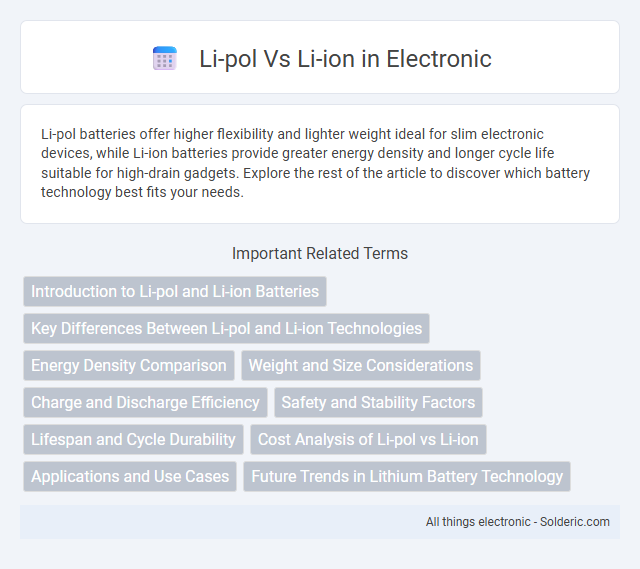Li-pol batteries offer higher flexibility and lighter weight ideal for slim electronic devices, while Li-ion batteries provide greater energy density and longer cycle life suitable for high-drain gadgets. Explore the rest of the article to discover which battery technology best fits your needs.
Comparison Table
| Feature | Li-Po (Lithium Polymer) | Li-ion (Lithium Ion) |
|---|---|---|
| Electrolyte | Polymer electrolyte | Liquid electrolyte |
| Shape & Weight | Flexible, lightweight, customizable shape | Rigid, heavier, standard cylindrical/prismatic shapes |
| Energy Density | Lower (~150-200 Wh/kg) | Higher (~180-250 Wh/kg) |
| Safety | More stable, less prone to leakage | Higher risk of leakage and thermal runaway |
| Cost | Higher manufacturing cost | Lower manufacturing cost |
| Applications | Wearables, drones, RC devices, flexible electronics | Smartphones, laptops, electric vehicles, power tools |
| Cycle Life | Typically 300-500 cycles | Typically 500-1000 cycles |
| Charge Rate | Moderate charge rate | Generally supports faster charging |
Introduction to Li-pol and Li-ion Batteries
Li-pol (Lithium Polymer) and Li-ion (Lithium-ion) batteries are popular energy storage technologies used in portable electronics and electric vehicles. Li-ion batteries offer high energy density and longer cycle life, while Li-pol batteries provide greater flexibility in shape and improved safety due to their solid or gel-like electrolyte. Understanding these differences helps you choose the best battery type for your specific power needs and device design.
Key Differences Between Li-pol and Li-ion Technologies
Li-pol batteries utilize a solid or gel-like polymer electrolyte, offering greater flexibility in shape and a thinner design compared to Li-ion batteries, which rely on a liquid electrolyte. Li-ion batteries generally provide higher energy density and longer cycle life, making them ideal for high-capacity applications, while Li-pol excels in lightweight, compact usage such as wearable devices. Your choice depends on whether you prioritize energy density and durability (Li-ion) or design versatility and safety (Li-pol).
Energy Density Comparison
Li-pol (lithium polymer) batteries typically offer slightly lower energy density compared to Li-ion (lithium-ion) batteries, with Li-ion cells reaching up to 250-270 Wh/kg while Li-pol cells range around 150-230 Wh/kg. The solid or gel-like electrolyte in Li-pol batteries sacrifices some energy density for increased safety and flexibility in design. Li-ion batteries remain preferred in applications where maximizing energy storage per weight is critical, such as in electric vehicles and portable electronics.
Weight and Size Considerations
Li-pol batteries provide significant weight and size advantages over Li-ion cells due to their flexible, lightweight polymer electrolyte, allowing for thinner and more varied shapes. Li-ion batteries typically have a heavier, rigid metal casing and fixed cylindrical or prismatic shapes, resulting in bulkier battery packs. These characteristics make Li-pol batteries ideal for compact, lightweight devices like smartphones, drones, and wearable tech.
Charge and Discharge Efficiency
Li-polymer (Li-pol) batteries typically offer higher charge and discharge efficiency compared to Li-ion batteries due to their flexible electrolyte design, which reduces internal resistance and heat generation. This increased efficiency means faster charging times and less energy loss during use, optimizing your device's overall performance. Choosing Li-pol can extend battery life by maintaining stable voltage and reducing stress during cycles.
Safety and Stability Factors
Li-pol (lithium polymer) batteries offer enhanced safety and stability due to their flexible, solid polymer electrolyte that reduces leakage and the risk of swelling compared to Li-ion batteries, which use liquid electrolytes prone to leak or catch fire under stress. The solid electrolyte in Li-pol cells provides better resistance to heat and punctures, making them safer for consumer electronics and portable devices. Your choice of battery should weigh these safety features against other factors like energy density and cost.
Lifespan and Cycle Durability
Li-pol batteries typically offer higher cycle durability with a life span of 500 to 1,000 charge cycles, making them ideal for lightweight and flexible applications. Li-ion batteries generally provide longer lifespan ranging from 1,000 to 2,000 cycles but may degrade faster under high-stress conditions. Your choice depends on prioritizing either longer lifespan or enhanced durability for your specific device needs.
Cost Analysis of Li-pol vs Li-ion
Li-pol (Lithium Polymer) batteries generally have a higher production cost compared to Li-ion (Lithium-ion) due to their advanced polymer electrolyte and flexible packaging technology, which allows for lightweight and compact designs. Li-ion batteries benefit from mass production efficiencies and established supply chains, resulting in lower per-unit costs and wider affordability for consumer electronics and electric vehicles. However, Li-pol batteries can provide better customization and safety features, potentially justifying the higher initial investment in applications requiring lightweight and form-factor flexibility.
Applications and Use Cases
Li-pol batteries excel in lightweight and flexible designs, making them ideal for drones, wearable devices, and smartphones where space and weight savings are critical. Li-ion batteries offer higher energy density and longer cycle life, commonly used in laptops, electric vehicles, and power tools that demand reliable, long-lasting power. Your choice depends on whether you prioritize portability and design flexibility (Li-pol) or energy capacity and durability (Li-ion).
Future Trends in Lithium Battery Technology
Li-pol batteries offer flexible form factors and improved safety, while Li-ion batteries provide higher energy density and cost efficiency, shaping ongoing advancement in portable device power sources. Research in solid-state electrolytes and silicon-based anodes aims to enhance energy capacity and battery longevity, signaling significant future improvements in both Li-pol and Li-ion technologies. Your choice in battery type will increasingly depend on applications requiring specific balances of flexibility, endurance, and safety as new materials and designs emerge.
Li-pol vs Li-ion Infographic

 solderic.com
solderic.com